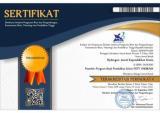Kapasitas Adsorpsi Zat Warna Malachite Green dan Violet Dye Menggunakan Metal Organic Frameworks (Fe-BDC)
Abstract
The presence of dye liquid waste from industry that is discharged into public drainage channels will cause environmental pollution, especially water ecosystems. The impact caused when exposed to waste such as health problems, such as allergies, skin irritation, cancer, and mutations in humans. The most widely used waste treatment method is adsorption. This method was chosen because it has high efficiency, easy, and cheap. The success of the adsorption method depends on the type of adsorbent used. One of the adsorbents that has a large adsorption capacity is metal organic frameworks. This study aims to determine the adsorption capacity using a sulvothermally synthesized Metal Organic Frameworks adsorbent using FeCl3.6H2O metal with terephthalic acid organic ligand. The dyes used as adsorbates are cationic malachite green (MG) and violet dye (VD) which are hazardous wastes from the textile industry in Bengkulu city. Determination of adsorption capacity is done by first determining the optimum conditions which include pH, contact time, adsorbent weight, and temperature. The optimum conditions for MG dye were at pH 5, at a mass of 2.5 mg, a contact time of 60 minutes, at a temperature of 30°C and a concentration of 50 ppm. While the VD dye was at a mass of 10 mg, a contact time of 40 minutes, pH 4, temperature 30°C and a concentration of 50 ppm. The adsorption capacity of MG and VD dyes were 625.00 mg/g and 384.61 mg/g.
Full Text:
PDFDOI: https://doi.org/10.33394/hjkk.v10i2.5220
Refbacks
- There are currently no refbacks.

This work is licensed under a Creative Commons Attribution-ShareAlike 4.0 International License.





